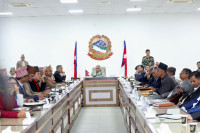National
Dense fog, low temperatures will continue over the next few days: Weather office
Kathmandu recorded its coldest day of the year yet, with mercury plummeting to 0.6 degrees Celsius, on Saturday.
Chandan Kumar Mandal
A thick blanket of fog in the southern plain districts is likely to continue, at least for the next few days with temperatures set to fall further, according to a prediction by the Meteorological Forecasting Division.
The adverse weather conditions, which began last week across the Tarai districts, have affected the daily lives from East to West districts, in the plains. There are no hints for the weather improving any time soon.
A senior meteorologist Shanti Kadel with the weather forecasting division said all places from eastern Nepal to western Nepal in Tarai region are currently covered in thick fog.
“All these places are experiencing very thick fog from the early morning,” Kadel told the Post. “In some places, it starts fading very gradually in the afternoon, whereas in other places, it might stay till the evening.”
The ongoing phenomenon blocks the sunlight and is making life harder for people and cattle living in those places. A special bulletin on Tarai Fog and Cold Wave by the division, on Saturday, showed that majority of the places in the Tarai districts were reeling under the thick fog from the morning, resulting in a drop in temperature and visibility.
On Saturday morning, the main cities of Tarai—Dhangadhi, Nepalgunj, Bhairahawa, Simara, Janakpur and Biratnagar—reported temperatures plummeting from the previous day. Kathmandu also witnessed its coldest day of the year, as the mercury fell to 0.6 degrees Celsius.
“In the next few days, there will be even a further decrease in temperature. There will be a rapid drop in Tarai” predicted Kadel. “In Tarai, even the average monthly maximum temperature has gone down and the minimum temperature has progressively fallen. People in the Tarai belt are advised to take care of themselves.”
The Tarai areas witnessed limited visibility with Janakpur having visibility of lower than 500 metres whereas others saw visibility falling to less than 50 metres.
Weather experts say the current phenomenon in the Tarai districts is not of a cold wave but strong fog. The arrival of westerly disturbances on December 13 and 14 had left behind the fog and cold wave.
According to Kadel, this year, the cold wave stayed briefly from December 16-18.
“At present, there are no cold waves, but only fog, which has caused a drop in temperature and visibility,” said Kadel. “The cold wave stays for a few days with a persistent drop in temperature over 24 hours, and it has water substance like droplets falling on the surface. It is different than a fog.”
The annual phenomenon of cold wave, mostly seen in southern plains districts, was not strong last year. Normally, the cold wave starts around mid-December and lasts up to February. The cold wave can last anywhere from a few days to a month, according to meteorologists. The cold wave had lasted for nearly a month in 1998 and 2002, the meteorological department records show.
Cold wave, which was first experienced in Nepal in 1995, has since emerged as one of the biggest threats to public life in the Tarai region. Every year, cold spells are getting longer and stronger, making it harder for the public to cope with a sudden drop in temperature and the formation of a thick blanket of fog.
Every year, dozens of people lose their lives to the chilling weather, propelled by the cold wave.
In 2013, a period of cold weather claimed nearly 50 lives. At least 26 people died of cold-related ailments during next winter of 2014.
Besides, poor visibility disturbs the traffic along the East-West highway, making roads prone to accidents, and it often leads to flight delays.
“It is said that cold wave and thick fog started during the 1990s with agriculture revolution in Uttar Pradesh and other Indian states, bordering Nepal,” said Kadel. “Pollution and moisture from the agricultural revolution helped in freezing the water vapour in the atmosphere. Dust particles in the air contribute greatly to the freezing of the water vapour.”
According to Kadel, although a major reason behind cold waves and fogs are meteorological, their frequency and intensity have gone up in recent years because of manmade factors.
Met department officials say that as of now, they are counting on the westerly disturbance, which is likely to enter the country by Wednesday or Thursday, for an improvement in the weather. The westerly winds are expected to wipe out the thick fog from the Tarai region, but the general conditions will remain overcast, they added.




 15.12°C Kathmandu
15.12°C Kathmandu















